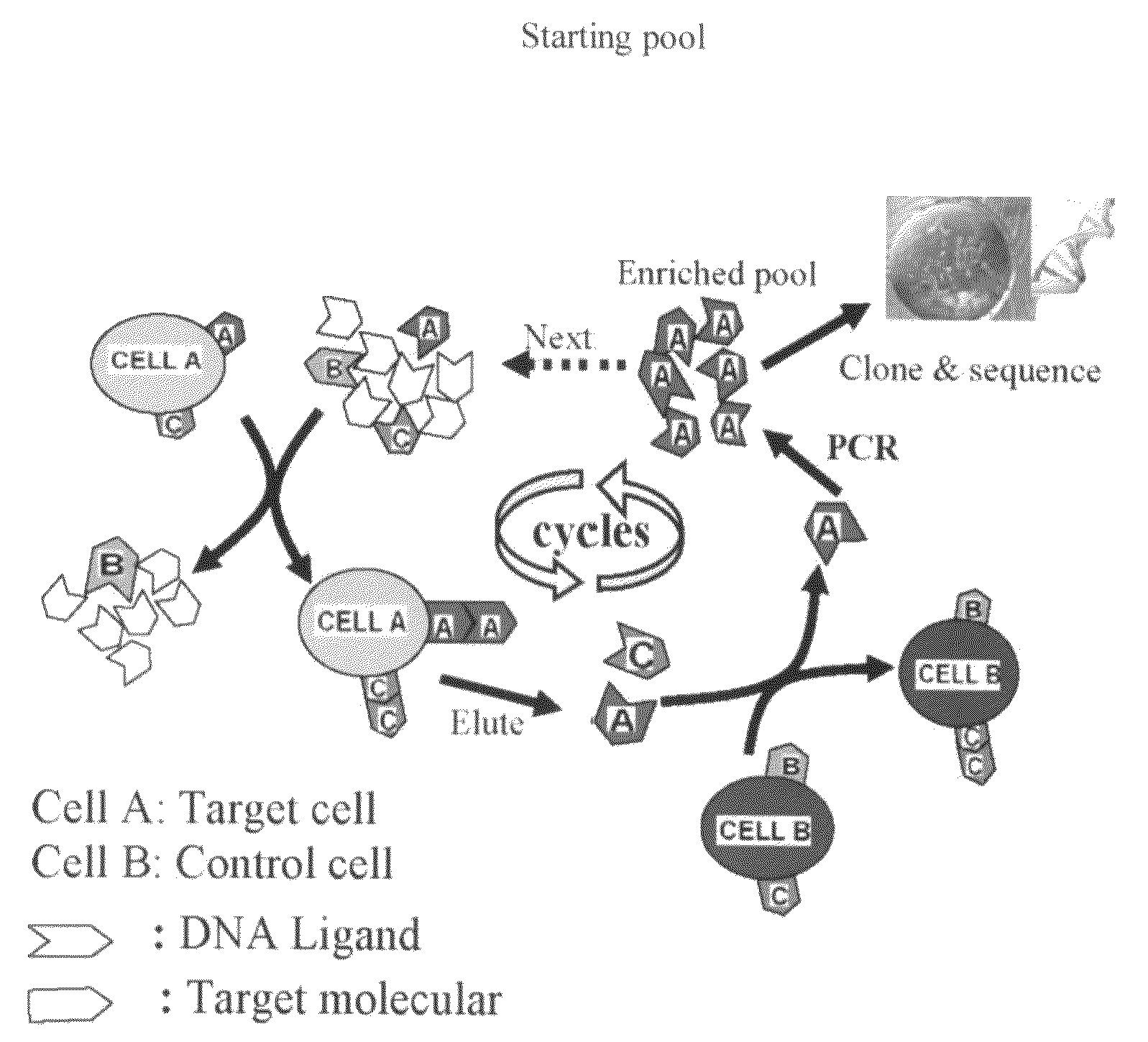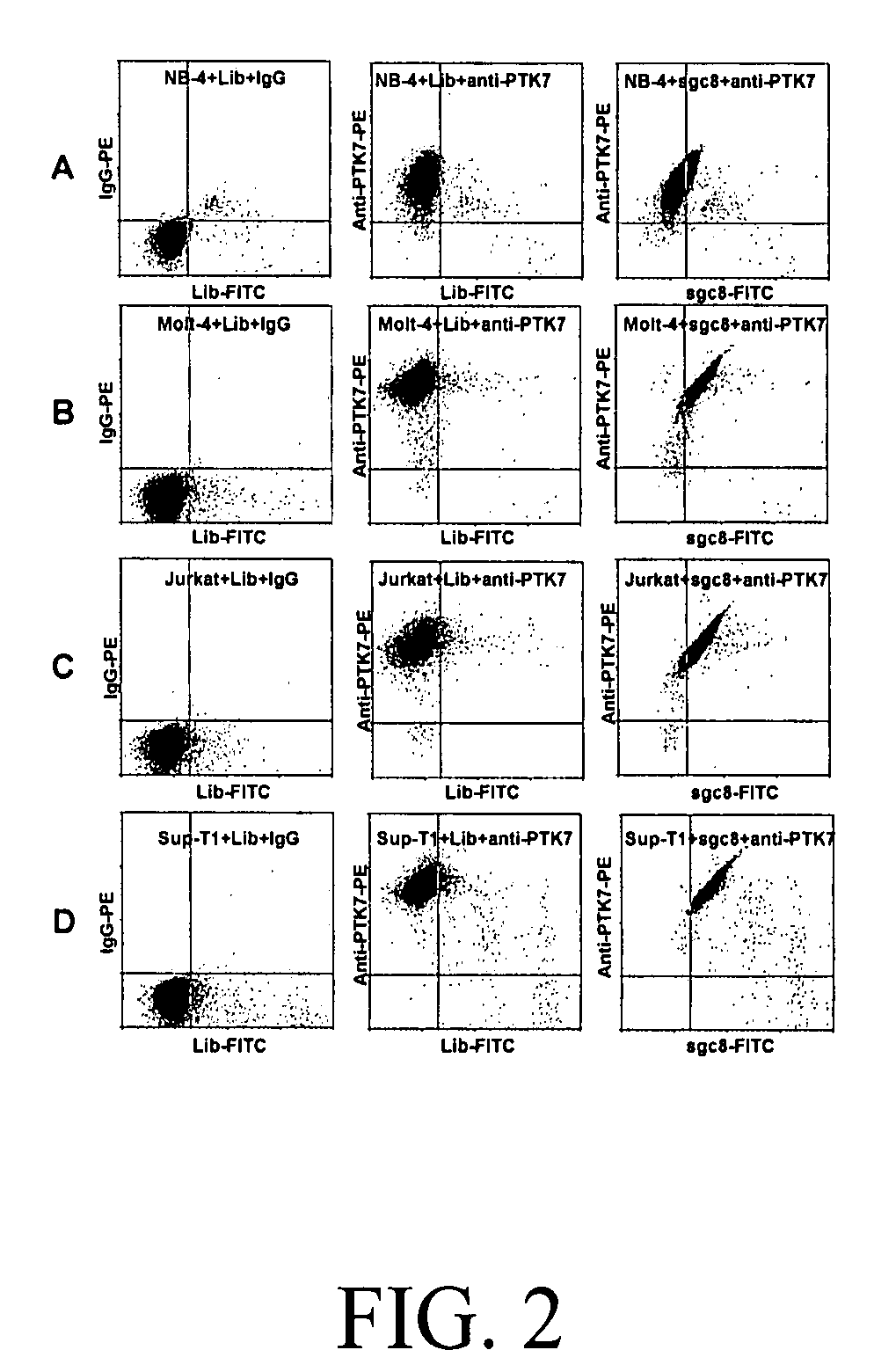Aptamer-based methods for identifying cellular biomarkers
a technology of cellular biomarkers and aptamer-based methods, which is applied in the direction of fluid pressure measurement, liquid/fluent solid measurement, peptides, etc., can solve the problems of insufficient number of samples, limited number of molecules identified as effective tumor markers, and non-standard technology platforms. achieve the effect of easy immobilization
- Summary
- Abstract
- Description
- Claims
- Application Information
AI Technical Summary
Benefits of technology
Problems solved by technology
Method used
Image
Examples
example 1
Materials
Cell Lines and Reagents
[0055]CCRF-CEM (CCL-119, T-cell lines, human acute lymphoblastic leukemia), Ramos, (CRL-1596, B-cell line, human Burkitt's lymphoma), Toledo (CRL-2631, B-cell line, human diffuse large cell lymphoma), Sup-T1 (CRL-1942, T-cell lines, human lymphoblastic leukemia), Jurkat (TIB-152, human acute T cell leukemia), Molt-4 (CRL-1582, T-cell lines, human acute lymphoblastic leukemia), were obtained from ATCC (American Type Culture Collection). NB-4 (acute promyelocytic leukemia) was obtained from the Department of Pathology, University of Florida). All the cells were cultured in RPMI 1640 medium (ATCC) supplemented with 10% fetal bovine serum (FBS) (heat inactivated, GIBCO) and 100 IU / mL penicillin-Streptomycin (Cellgro). Cells were washed before and after incubation with wash buffer (4.5 g / L glucose and 5 mM MgCl2 in Dulbecco's phosphate buffered saline with calcium chloride and magnesium chloride (Sigma)). Binding buffer used for selection was prepared by a...
example 2
Cell-SELEX
[0082]Cell-based SELEX procedure (Aptamer selection): The cell-SELEX procedure is schematically shown in FIG. 6. Synthesized ssDNA library was incubated with target cells. After washing, the bound DNAs were eluted by heating. The collected DNAs were then incubated with negative cells for counter-selection in order to remove the sequences binding to coexisting molecules on both cells. After centrifugation, the supernatant was collected and the selected DNA pool was amplified by PCR. The PCR products were separated into ssDNAs for next round selection. After the DNA pool reached certain cell-binding affinity, the enriched pool was cloned and sequenced. Aptamers were identified from the sequenced pool. These aptamers have Kd in the range of nM to pM: sgc3: 1.97 nM, sgc4: 26.6 nM, sgc8: 0.8 nM, sgd2: 7.2 nM, sgd3: 3.58 nm, and sgd5: 70.8 nM. Aptamer sgd5 was selected from Toledo cells, a human diffuse large B cell lymphoma cell line. All the other aptamers were from CCRF-CEM c...
example 3
Cell Lines and Buffers
[0101]CCRF-CEM (CCL-119, T-cell lines, human acute lymphoblastic leukemia), Ramos, (CRL-1596, B-cell line, human Burkitt's lymphoma), Toledo (CRL-2631, B-cell line, human diffuse large cell lymphoma), Sup-T1(CRL-1942, T-cell lines, human lymphoblastic leukemia), Jurkat (TIB-152, human acute T cell leukemia), Molt-4 (CRL-1582, T-cell lines, human acute lymphoblastic leukemia), SUP-B15 (CRL-1929, B-lymphoblast, human acute lymphoblastic leukemia) and U266 (TIB-196, B-lymphocyte, human myeloma, plasmacytoma) were obtained from ATCC (American Type Culture collection). Mo2058 (Mantle-cell lymphoma, Epstein-Barr Virus-positive cell line) and NB-4 (acute promyelocytic leukemia) were obtained from Department of Pathology, University of Florida). All the cells were cultured in RPMI 1640 medium (ATCC) supplemented with 10% fetal bovine serum (FBS) (heat inactivated, GIBCO) and 100 IU / mL penicillin-Streptomycin (Cellgro). Cells were washed before and after incubation with...
PUM
| Property | Measurement | Unit |
|---|---|---|
| pH | aaaaa | aaaaa |
| volume | aaaaa | aaaaa |
| affinity | aaaaa | aaaaa |
Abstract
Description
Claims
Application Information
 Login to View More
Login to View More - R&D
- Intellectual Property
- Life Sciences
- Materials
- Tech Scout
- Unparalleled Data Quality
- Higher Quality Content
- 60% Fewer Hallucinations
Browse by: Latest US Patents, China's latest patents, Technical Efficacy Thesaurus, Application Domain, Technology Topic, Popular Technical Reports.
© 2025 PatSnap. All rights reserved.Legal|Privacy policy|Modern Slavery Act Transparency Statement|Sitemap|About US| Contact US: help@patsnap.com



